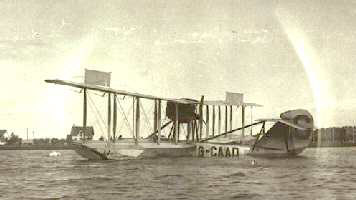 Naval Aviator Insignia |
AIRCRAFTOF THEA E F |
Curtiss HS-1L and -2L Flying Boats

Model HS-2L
Development and OperationEarly in 1917, Glenn Curtiss used the hull of the H-14 flying boat, which the U.S. Army had rejected, to design a high-powered, single-engine, flying boat. The effort resulted in an aircraft, powered by a Curtiss OXX engine with the crew siting alongside of each other. The prototype, known as the HS-1, first flew from the Niagara River at Buffalo, NY at the end of June. When the American military endorsed the recommendations of the Bolling Commission to standardize the selection of aircraft engines in the Liberty engine Curtiss installed the 330 hp Liberty V-12 in the HS-1 making it now known as the HS-1L. The weapons carried by the HS-1L consisted of a single Lewis machine gun in the nose of the aircraft and two 180-lb. depth charges, one under each wing. The U.S. Navy immediately selected the HS-1L as a standard coastal patrol aircraft. When the British Admiralty notified the American government that the 180-lb. depth charges were insufficient against the submarine they recommend the use of a 230-lb. depth charges. In order for the HS-1L to carry the extra weight of the heavier depth charges design changes were necessary. The principle changes was a revision to the fuel system, an increase in the area of the rudder, and the addition of four six ft. panels, one on each side of both the upper and lower wings adjacent to the outboard extension panels. In its revised configuration the aircraft became known as the HS-2L. A total of 1218 HS-1L and -2L aircraft were built. It is difficult to specify just how many of each type were built since many HS-1L were converted to the –2L configuration in the field. In the United States the HS-1L and –2L were flown at the Naval Air Stations at Rockaway, San Diego, and Hampton Roads. Overseas, the aircraft were flown by the Marines at NAS Ponta Del Gato in the Azores and at the following naval air stations in France: L'Aber Vrach, Tréquier, Brest, Moutchic, Le Croisic, Paulliac, Ile Trudy, and St.Trójan. |
Aircraft and Flight Characteristics
|
Span-upper plane |
74' 19/32" |
|
Span-lower plane |
64' 1 2/32" |
|
Length |
40' 0" |
|
Height |
14' 7 ¼"14' 7 ¼" |
|
Hull Weight |
1,265 lbs. |
|
Fuel |
124.8 gallons in three tanks |
|
Oil |
13.34 gallons |
|
Engine |
330 hp Liberty V-12 |
|
Armament |
1 Lewis Gun; |
|
Maximum Speed |
91 mph |
|
Minimum Speed |
53 mph |
|
Climb in three minutes |
500 ft. |
References:
1. HS-1L Flying Boat Handbook, U.S. Navy Department 2. Molson, K.M. and A.J. Shortt, The Curtiss HS Flying Boats,
Naval Institute Press
To find other Doughboy Features visit our |
Membership Information  Click on Icon |
For further information on the events of 1914-1918
visit the homepage of |
Michael E. Hanlon (medwardh@hotmail.com) regarding content,
or toMike Iavarone (mikei01@execpc.com) regarding form and function.
Original artwork & copy; © 1998-2000, The Great War Society